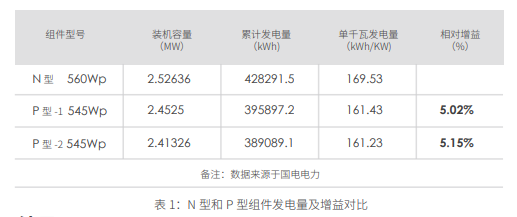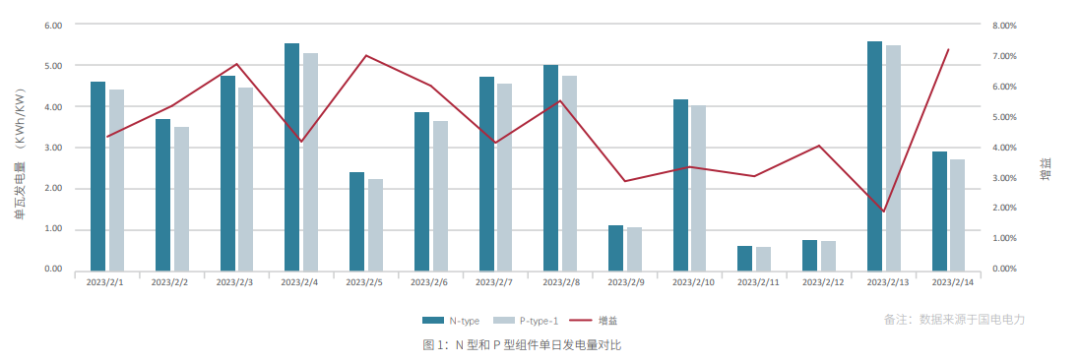Project Overview:
In the 30MW photovoltaic power plant built by Guodian Power in Jizhou District, Tianjin, we conducted a comparative study on the power generation performance of bifacial photovoltaic modules equipped with TOPcon and PERC cell technologies. The project is located in Jizhou District, which belongs to the warm temperate semi humid continental monsoon climate. It has four distinct seasons, abundant sunshine, abundant heat, high temperature and rain in summer, and cold winter. The total annual solar radiation amount reaches 1450~1600kWh/m2 (5220~5760 MJ/m2), and the light resource conditions are excellent, which is conducive to the development and construction of photovoltaic projects.
Project Design:

The project has a rated capacity of 30MW and consists of 12 2.5MW photovoltaic power generation units. Each string is designed to consist of 26 components, and every 17 strings are connected to one string inverter. Each power generation unit is equipped with 11 225kW string inverters and 1 2500 kVA box transformer, with a capacity ratio of 1. The bracket selection is fixed, with an inclination angle of 30 °. The vertical two row bracket scheme is adopted, and the minimum height of the component from the ground is 0.5 meters. In order to visually compare the power generation differences of N/P type components under actual operating conditions, the project installed a total of 20MW of P-type double glass 545 components, and a total of 10MW of N type double glass 560W components.
result:
 Based on the power generation performance advantages of N-type TOPCon components such as lower temperature coefficient, higher double-sided rate, and lower photo induced attenuation, compared to conventional P-type PERC components, it can bring at least 3% power generation gain under the same DC side capacity. Based on actual situation analysis, due to the high summer ambient temperature in the climate zone where the project is located, the extreme high temperature can reach 40 degrees Celsius. After considering the heating up of the module itself, the operating temperature of the module can reach nearly 60 degrees Celsius. A better temperature coefficient of the module can reduce the impact of temperature on the output power of the module. The Tiger Neo series module equipped with TOPCon technology battery cells has a temperature coefficient as low as -0.29%/℃, which will effectively improve the power generation of the module under the same working conditions. By comparing the power generation of an N-type component array with two P-type component arrays, it was found that compared to conventional P-type PERC modules, the single kilowatt power generation gains of the Jingke N-type TOPCon module reached 5.02% and 5.15%, respectively, strongly supporting the excellent performance of the N-type module in practical outdoor applications.
Based on the power generation performance advantages of N-type TOPCon components such as lower temperature coefficient, higher double-sided rate, and lower photo induced attenuation, compared to conventional P-type PERC components, it can bring at least 3% power generation gain under the same DC side capacity. Based on actual situation analysis, due to the high summer ambient temperature in the climate zone where the project is located, the extreme high temperature can reach 40 degrees Celsius. After considering the heating up of the module itself, the operating temperature of the module can reach nearly 60 degrees Celsius. A better temperature coefficient of the module can reduce the impact of temperature on the output power of the module. The Tiger Neo series module equipped with TOPCon technology battery cells has a temperature coefficient as low as -0.29%/℃, which will effectively improve the power generation of the module under the same working conditions. By comparing the power generation of an N-type component array with two P-type component arrays, it was found that compared to conventional P-type PERC modules, the single kilowatt power generation gains of the Jingke N-type TOPCon module reached 5.02% and 5.15%, respectively, strongly supporting the excellent performance of the N-type module in practical outdoor applications.
Conclusion:
Based on the comparison and analysis of the single kilowatt power generation of P-type PERC and N-type TOPCon components, the excellent power generation performance of TOPCon components, which is different from conventional PERC components, has been fully highlighted. Generally speaking, in summer applications, the power generation of photovoltaic modules will also increase with the increase of sunlight, but the subsequent component heating will reduce the power generation efficiency of P-type modules, thereby affecting project profits. As a result, the priority of using N-type TOPCon components with better temperature coefficients for hot application environments has been further enhanced. Moreover, unlike conventional PERC modules with boron doping on the substrate, choosing the substrate phosphorus doping process for the Jingke Energy N-type TOPCon module can effectively reduce the photoinduced attenuation of the module. With the selection of high-quality auxiliary materials, it can safeguard the customer's full life cycle power generation revenue level from the power output level.
In terms of power attenuation performance, N-type components have natural advantages, with a first year attenuation of 1% and an annual linear attenuation of 0.4%, while P-type components have a first year attenuation of 2% and an annual attenuation of 0.45%. Due to power attenuation, N-type components bring about a power generation gain of about 1.8%. In terms of high-temperature power generation performance, it is closely related to the temperature coefficient of the component and the operating temperature of the component. The temperature coefficient of the N-type component is -0.29%/℃, while the temperature coefficient of the P-type component is -0.35%/℃. Under high temperature conditions in summer, assuming the operating temperature of the component is around 55 ℃ (ambient temperature is around 30 ℃), the power loss of the N-type component is about 1% lower than that of the P-type component, and as the operating temperature of the component further increases, The advantage of high-temperature power generation of N-type components will be more prominent.
Meanwhile, due to its higher conversion efficiency, the N-type module reduces the thermal conversion of absorbed light energy, thereby lowering the operating temperature of the module. This is fully confirmed by the 30MW Tianjin project. The average operating temperature of N-type components is about 1 ℃ lower than that of P-type components. Combined with excellent temperature coefficient and lower operating temperature, the power generation of N-type components is about 2% higher than that of P-type components. In terms of double-sided power generation performance, the double-sided ratio of N-type components is about 80%, and the double-sided ratio of P-type components is about 70%. Therefore, the difference in double-sided ratio (10%) brings a power generation gain of N-type components between 1% and 1.5%.
Theoretical analysis shows that due to its excellent power attenuation characteristics, high-temperature power generation performance, double-sided power generation performance, and low irradiation power generation performance, the theoretical power generation gain of the N-type component is about 3%. However, empirical project data shows that the single watt power generation of the N-type component is more than 5% higher than that of the P-type component, which is much better than the theoretical gain. The power generation performance of the N-type component has been fully verified, Provide a certain technical basis for the selection of photovoltaic product technology routes and the selection of customer component products. In addition, this result also reflects the significant "four high and four low" advantages of N-type TOPCon components, namely high power, high efficiency, high double-sided rate, and high power generation, as well as low attenuation, low temperature coefficient, low BOS, and low LCOE
